|
TennisOne Lessons

Moving Footwork and Hitting Footwork
Jim McLennan, Senior Editor, TennisONE
To see the animation of movement to forehand,
click here.
To see the animation of movement to backhand, click
here.
Get to the Ball Early and Setup Early
Sounds fairly simple, get to the ball early and setup early.
But why is it that some players we see at the club are graceful and balanced
and others are off balance? Why is it that some players get to the ball
quickly and seem to be waiting, and others always appear rushed? Why? Because
it's far more difficult than it sounds.
As you will see in the photo sequences below, I am demonstrating
quick footwork to the ball. At the end of my run I regain my balance so
I can create a little extra time on the back foot before I begin my swing.
In the initial running steps I am truly in a running mode, with arms swinging
and my body in a running posture. As I arrive near the hitting spot
I begin to straighten up, regain my balance, and take small quick steps
to re-establish my back foot. The final quick steps allow me to time the
final "step and swing".
Get a running start to the ball
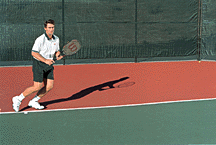 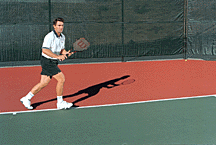
My initial step unweights the outside foot as I turn,
so I am running almost immediately. The goal
is to get there early (Note: this initial step, and the technique behind
it will be clearly examined in future articles on the "Gravity Step.")
Finish your positioning steps on the back foot
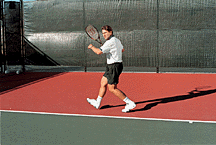 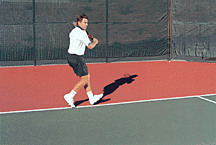
My final steps allow me to regain my balance. Posture is
very important--graceful, balanced, weighting the back foot. Note,
as you experiment with this "waiting" position, the body weight
must be on the ball and inside of the back foot, feeling tall and graceful,
not "back on your heels."
Wait for the ball
Wait for the ball, then unwind with a rhythmic step-and-swing
(this construction of words and hyphens is trying to show the time between
the step and the swing is quick and short).
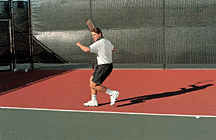 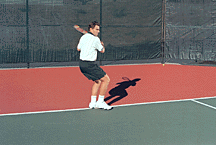
When I am on balance I can indeed wait. I have the
sensation of pausing before starting the swing and having real time to hit
the ball. When I am on the back foot but off-balance,
then I will not wait as long or as well.
Finally, we always try to tie these instructional articles
with professional examples. In this instance, Jimmy Connors would
be the absolute best example of moving quickly, regaining balance, and then
coming against the ball. And though we remember Connors also for
jumping as he hit, I believe that had more to do with his intent to "raise"
the point of contact, than with any advantage he would have had from jumping,
for certainly if jumping helped, then we would also see it in baseball and
golf. Whether to "jump or not to jump" is not widely agreed upon
within the tennis community, and can certainly be the subject of future
articles. In this controversy, you can expect to see this author develop
the "not to jump" position. In the meantime, as you practice quick
positioning movements with a balanced yet unhurried hitting style, keep
Connors in mind. Get there early. Wait. Come against the ball.
To see the animation of movement to forehand,
click here.
To see the animation of movement to backhand, click
here.
Send email to the author
We encourage you to email your comments (pro, con, appreciative, whatever)
directly to the author. To send email to Jim McLennan, click
here.
Go To:
Other Footwork Lessons In Lessons Library
Top of Lessons Library
Back to TennisONE Home Page
What's New | Tennis
Lessons | Tennis
in Your Area
Tennis Fitness | Tennis
Products | Sponsors/Advertisers/Consultants
webmaster@tennisone.com
TennisONE© is a trademark of TennisONE© and SportsWeb ONE©.
Copyright© 1995. All rights reserved.
|